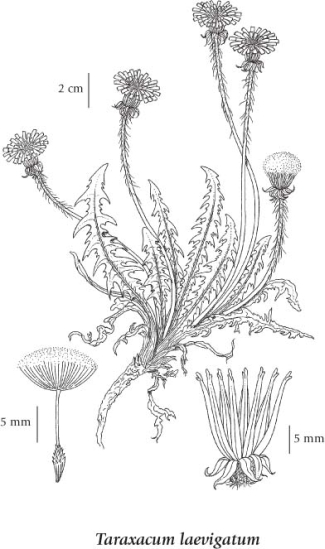Taraxacum erythrospermum
red-seeded dandelion
Asteraceae (Aster family)
Introduction to Vascular Plants
red-seeded dandelion
Asteraceae (Aster family)
Introduction to Vascular Plants
Species Information
General:
Perennial herb from a simple or branched stem-base and a thick, often deep taproot; stems erect, solitary to several, simple, hollow, glabrous or sometimes hairy above, exuding milky juice when broken, 10-60 cm tall.
Leaves:
Basal leaves oblanceolate to lanceolate, 5-25 cm long, 1-4 cm wide, tapering basally to a more or less winged stalk, deeply pinnately cut or pinnately divided into backward-pointing, narrow, triangular-lanceolate lobes with segments tapered to a slender tip, the terminal lobe not much larger than the lateral ones, glabrous or nearly so; stem leaves lacking.
Flowers:
Heads with strap-shaped flowers, solitary; involucres 10-20 mm tall; involucral bracts in 2 series, the outer ones egg-shaped to lanceolate, appressed to ascending or sometimes reflexed, glabrous or long-hairy, the inner ones lance-oblong, long-pointed, usually horned at the tips; ray flowers yellow, the outer ones often purplish on the outside; disk flowers lacking.
Fruits:
Achenes 3-4 mm long, not including the slender beak which is 1 to 2, sometimes 3 times the length of the body, red or reddish-brown, sharply ribbed and conspicuously spiny above; pappus of numerous, 4-7 mm long, white to dull white hairlike bristles.
Illustration

If more than one illustration is available for a species (e.g., separate illustrations were provided for two subspecies) then links to the separate images will be provided below. Note that individual subspecies or varietal illustrations are not always available.
Illustration Source: The Illustrated Flora of British Columbia
Ecology
Ecological Framework for Taraxacum erythrospermum
The table below shows the species-specific information calculated from
original data (BEC database) provided by the BC Ministry of Forests and Range.
(Updated August, 2013)
The table below shows the species-specific information calculated from
original data (BEC database) provided by the BC Ministry of Forests and Range.
(Updated August, 2013)
| Site Information |
Value / Class |
||
|
Avg |
Min |
Max |
|
| Elevation
(metres) |
864 | 808 | 975 |
| Slope
Gradient (%) |
21 | 10 | 30 |
|
Aspect (degrees) |
149 | 75 | 225 |
| Soil
Moisture Regime (SMR) [0 - very xeric; 4 - mesic; 8 - hydric] |
3 | 2 | 5 |
| Modal
Nutrient Regime
Class |
D | ||
| #
of field plots species was recorded in: |
3 | ||
| Modal
BEC Zone Class |
PP | ||
|
All BEC Zones (# of stations/zone) species was recorded in |
IDF(1), PP(1) | ||
|
Source:
Klinkenberg 2013
|
|||
Habitat and Range
Mesic to dry roadsides, fields, gardens and waste places in the lowland, steppe and montane zones; frequent in S BC; introduced from Europe.Status Information
Synonyms
Synonyms and Alternate Names:
Taraxacum laevigatum (Willd.) DC.